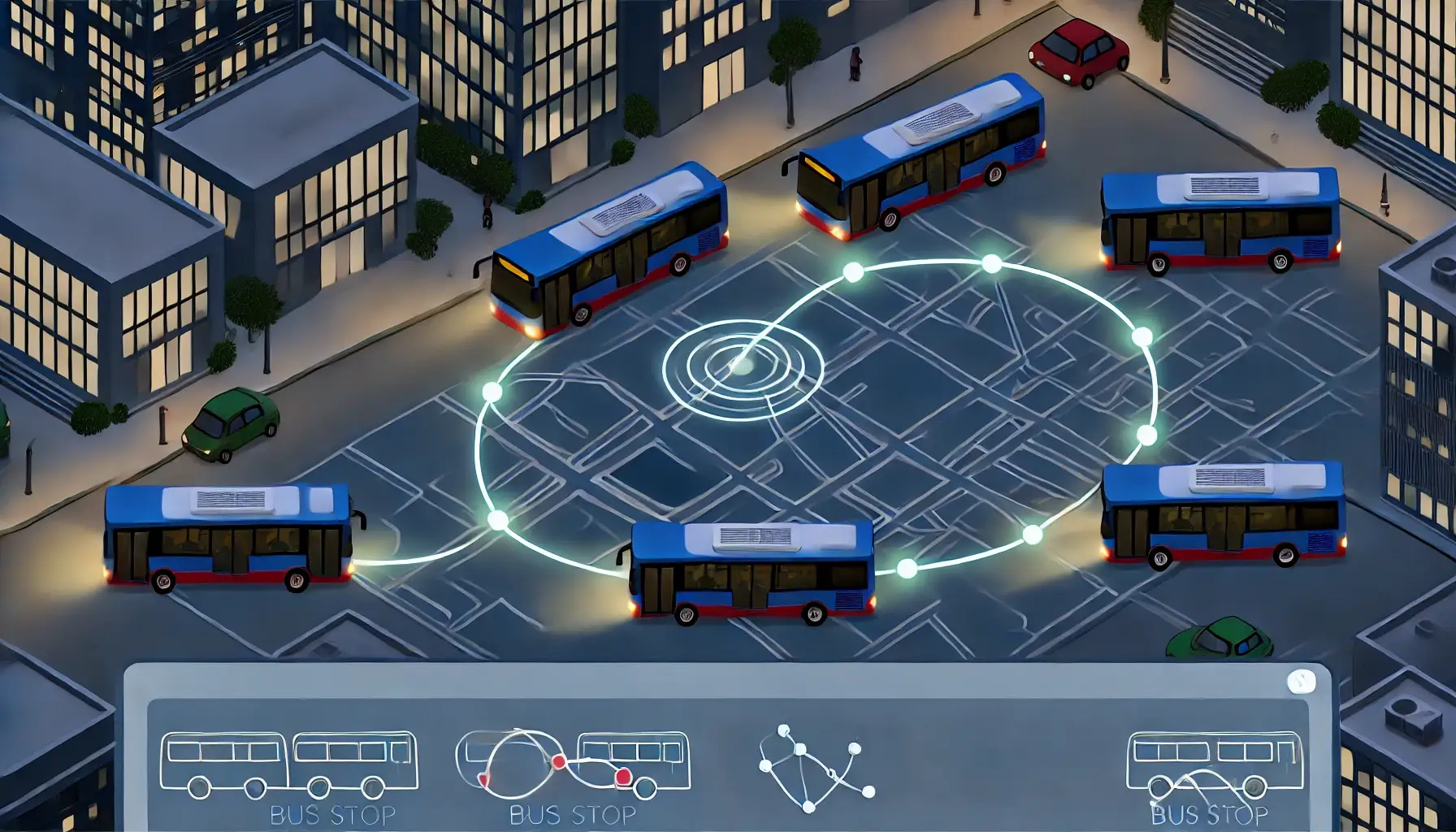
公交路线 815
考虑到未来找实习和工作的需要,至少在心血来潮的时候刷刷LeetCode,顺便进行C++复健,顺便学学其他语言的语法。写下这道题也是在mark一个开始。这个难度的题大概以后也不会都写。。有(看)感(心)悟(情)或者足够变态的题目再写吧。
顺便感叹下DALL-E现在越来越厉害了。前几个博客的图都是生成的。
题目
给你一个数组 routes,表示一系列公交线路,其中每个 routes[i] 表示一条公交线路,第 i 辆公交车将会在上面循环行驶。
例如,路线 routes[0] = [1, 5, 7] 表示第 0 辆公交车会一直按序列 1 -> 5 -> 7 -> 1 -> 5 -> 7 -> 1 -> ... 这样的车站路线行驶。
现在从 source 车站出发(初始时不在公交车上),要前往 target 车站。 期间仅可乘坐公交车。
求出最少乘坐的公交车数量。如果不可能到达终点车站,返回 -1。
示例
示例 1:
输入:
routes = [[1,2,7],[3,6,7]], source = 1, target = 6
输出:2
解释:最优策略是先乘坐第一辆公交车到达车站 7,然后换乘第二辆公交车到车站 6。
示例 2:
输入:
routes = [[7,12],[4,5,15],[6],[15,19],[9,12,13]], source = 15, target = 12
输出:-1
提示:
1 <= routes.length <= 5001 <= routes[i].length <= 10^5routes[i]中的所有值 互不相同sum(routes[i].length) <= 10^50 <= routes[i][j] < 10^60 <= source, target < 10^6
分析与解答
两年没做算法题目了。既然是复健,我将从直觉开始想。要求的是公交车数量,将两个车站之间的距离定义为公交车数量。循环行驶,说明可以看作是无向图。 这样一来,直接能想到的办法就是BFS。先不考虑优化,写出第一版。基本思路是从车站开始,遍历过这个站的车,更新到达站点的深度。根据BFS的特性,第一次到达站点的深度就是最小的。
基础复盘
vector
开始之前,我发现我需要快速过一下vector的用法。其他的STL用到再说。
1234567891011121314151617181920212223242526#include <iostream>
#include <vector>
using namespace std;
int main() {
vector<int> v = {1, 2, 3, 4, 5};
// visit
int first_elem = v[0]; // or v.front();
int last_elem = v[v.size() - 1]; // or v.back();
int second_elem = v.at(1);
// modify
v.push_back(6);
v.pop_back();
v.erase(v.begin() + 2);
v.erase(v.begin(), v.begin() + 2);
v.insert(v.begin() + 1, 10); // index 1
// traverse
for (int i : v) { // or for (int i = 0; i < v.size(); i++)
cout << i << " ";
}
return 0;
}
unordered_map
然后反向建图需要一个hash,这里用unordered_map。
1234567891011121314151617181920212223242526272829303132333435#include <unordered_map>
using namespace std;
int main() {
unordered_map<int, string> umap = {{1, "one"}, {2, "two"}, {3, "three"}};
// insert
umap.insert({4, "four"});
umap[5] = "five";
// visit
string value = umap[1];
string value2 = umap.at(2);
// modify
umap[1] = "ONE";
// traverse
for (auto i : umap) { // or for (auto i = umap.begin(); i != umap.end(); i++)
cout << i.first << " " << i.second << endl;
}
// find
auto it = umap.find(1);
if (it != umap.end()) {
cout << "Found " << it->first << " " << it->second << endl;
}
// delete
umap.erase(1);
umap.clear(); // clear all
cout << umap.size() << umap.empty() << endl;
return 0;
}
用起来和Python还是很像的。实际复健的时候感觉C++也没那么难。可能是因为当时上课的时候不让用STL,一直没有简单的hash之类的用。。当时还自己写了好多板子:github
queue
最后是queue,BFS的核心数据结构。就进进出出:
123456789101112131415161718192021222324#include <queue>
using namespace std;
int main() {
queue<int> q;
q.push(1);
q.push(2);
q.push(3);
// visit
int front_elem = q.front();
int back_elem = q.back();
// pop
q.pop();
// traverse
while (!q.empty()) {
cout << q.front() << " ";
q.pop();
}
return 0;
}
第一版代码
于是,第一版代码:
1234567891011121314151617181920212223242526272829303132333435363738394041class Solution {
public:
int numBusesToDestination(vector<vector<int>>& routes, int source, int target) {
if (source == target) {
return 0;
}
// get station2bus
unordered_map<int, vector<int>> station2bus;
for (int i = 0; i < routes.size(); i++) {
for (int station : routes[i]) {
station2bus[station].push_back(i);
}
}
unordered_map<int, int> depth;
// BFS
queue<int> q;
q.push(source);
depth[source] = 0;
while (!q.empty()) {
int cur_station = q.front();
int cur_depth = depth[cur_station];
q.pop();
for (int bus : station2bus[cur_station]) {
for (int station : routes[bus]) {
if (station == target) {
return cur_depth + 1;
}
else if(depth.find(station) == depth.end()) {
depth[station] = cur_depth + 1;
q.push(station);
}
}
}
}
return -1;
}
};
过了一下测试,发现source target相等的时候不需要先上车再原地下车。。,不过总之这是一个特判。
测试结果是有一个case超时。分析一下时间,记辆车,路线长。反向建图的时间复杂度是,BFS的时间复杂度是。所以按理说没问题才对?
仔细检查一下,发现实际上是因为BFS的时候,每次都要遍历一遍所有的车。构造极端情况:所有车首位相连成一条线。那么每个route交点上,都要遍历所有的车,再遍历所有站,时间复杂度就是。其实车看着不多,容易忽略这个复杂度。
第二版代码
总之,每个bus只需要访问一次就可以了。在上面的基础上加入一个bus_visit,使用unordered_set,用法简单就不再讲了:
12345678910111213141516171819202122232425262728293031323334353637383940414243444546class Solution {
public:
int numBusesToDestination(vector<vector<int>>& routes, int source, int target) {
if (source == target) {
return 0;
}
// get station2bus
unordered_map<int, vector<int>> station2bus;
for (int i = 0; i < routes.size(); i++) {
for (int station : routes[i]) {
station2bus[station].push_back(i);
}
}
unordered_map<int, int> depth;
unordered_set<int> bus_visit;
// BFS
queue<int> q;
q.push(source);
depth[source] = 0;
while (!q.empty()) {
int cur_station = q.front();
int cur_depth = depth[cur_station];
q.pop();
for (int bus : station2bus[cur_station]) {
if (bus_visit.find(bus) != bus_visit.end()) {
continue;
}
bus_visit.insert(bus);
for (int station : routes[bus]) {
if (station == target) {
return cur_depth + 1;
}
else if(depth.find(station) == depth.end()) {
depth[station] = cur_depth + 1;
q.push(station);
}
}
}
}
return -1;
}
};
过。感觉其他细节也不算很重要,不继续优化了。简单说下优化思路:首先是更多特判,比如超出范围。然后深度不需要全部记下来,因为BFS是按层往下的,记录层数就够了。
顺便感叹一下今天收到的春江花月夜键盘(帽)。当初看到的时候就觉得特别变态!鉴定为盲打速成键盘。不知为何虽然平时基本也是盲打,但是用这个就是容易打错。难道其实平时有用余光?神奇。

题目 Link:公交路线 815
